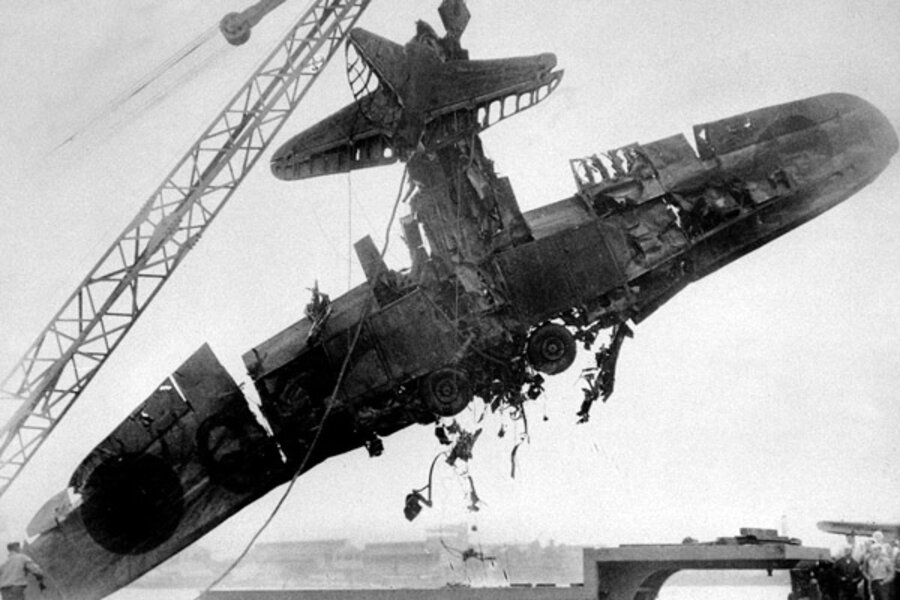Pearl Harbor skull unearthed, may be Japanese pilot
Loading...
| HONOLULU
Forensic scientists are conducting tests on a skull unearthed at the bottom of Pearl Harborto determine if it belonged to a Japanese pilot who died in the historic attack on Dec. 7, 1941.
An excavation crew dredging the harbor recently made the startling discovery of the skull, which archeologists believe is from one of the Japanese aviators in the surprise attack.
Archaeologist Jeff Fong of the Naval Facilities Engineering Command Pacific described the finding to The Associated Press and the efforts under way to identify the skull. He said the early analysis has made him "75 percent sure" that the skull belongs to a Japanese pilot.
He did not provide specifics about what archaeologists have learned about the skull, but said it was not from one of Hawaii's ancient burial sites. They also contacted local police and ruled out the possibility that it's from an active missing person case, said Denise Emsley, public affairs officer for the Naval Facilities Engineering Command Hawaii, which was being inundated with media calls Wednesday about the skull from international news organizations.
The skull was in water between 35 and 40 feet deep, Don Rochon, public affairs officer for NAVFAC Pacific said Thursday.
The items found with the skull, which was determined not to be from a Native Hawaiian, provided some clues: forks, scraps of metal and a Coca-Cola bottle Fong said researchers have determined was from the 1940s.
Fifty-five Japanese airmen were killed and 29 of their aircraft were shot down in the attack, compared with the 2,400 U.S. service members who died. No Japanese remains have been found at Pearl Harbor since World War II.
Pearl Harbor is home to the USS Arizona Memorial, which sits on top of the battleship that sank during the attack. It still holds the bodies of more than 900 men.
"I think it is important and an interesting find," said Michael Pietrusewsky, professor of anthropology at the University of Hawaii. "It would be interesting because finding the remains of Japanese servicemen from that long ago at Pearl Harbor is quite rare."
Pietrusewsky noted that Fong, a former student of his, is one of a handful in Hawaii with expertise in areas including physical and forensic anthropology and excavation of ancient Hawaiian remains.
It was April 1 when items plucked from the water during the overnight dredging were laid to dry. When it was determined a skull was among the dredged items, contractors were ordered to stop the work, Emsley said. "We definitely wanted it to be handled correctly," she said.
"That's why it's been kept quiet. We didn't want to excite people prematurely," she said.
The Joint POW/MIA Accounting Command on Oahu, charged with identifying Americans who were killed in action but were never brought home, has been asked to determine who the skull belongs to. The cranium was turned over to the command's lab for tests that will include examining dental records and DNA, said John Byrd, the lab's director and a forensic anthropologist.
"We're working on the case but the case is just in the early stages of analysis," he said. "We're not going to know much more about it for a while yet."
The lab is the only accredited Skeletal Identification Laboratory in the United States. JPAC has identified more than 560 Americans since the command was activated in 2003. When more information is gleaned from theskull, other agencies could get involved including the Naval Criminal Investigative Service and the Japanese Consulate.
JPAC spokesman U.S. Army Maj. Ramon Osorio said forensic archeologists and anthropologists assigned to identify human remains are "working in the blind," meaning they're not given any information about what is believed about the case.
"We want to them to essentially have no prejudice or predisposition about what they think it could be," he said. "It's human nature to want to solve the problem."
The shape of the skull's eye sockets can help reveal ancestry, said Lawrence Kobilinsky, professor of forensic science at the John Jay College of Criminal Justice in New York City.
Daniel Martinez, the National Park Service's chief historian for Pearl Harbor, said experts on Pearl Harbor know enough about the specific location where Japanese planes went down in the attack that they might be able to match the skull with a crewmember.
"They landed in a variety places throughout Pearl Harbor and the island of Oahu," Martinez said. "In the area of Pearl Harbor, we know what plane was shot down and who was in the crew."
Martinez said that beyond the historical significance of the finding, it is a reminder of a life lost.
"I think that anytime you're able to reclaim a casualty and perhaps even identify it, regardless of what country, it may bring closure to a family," he said.





